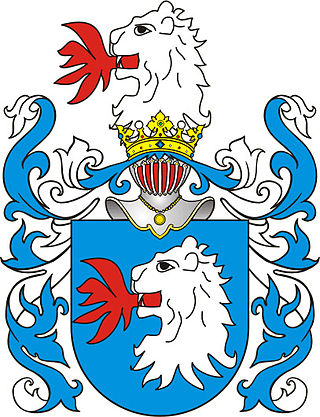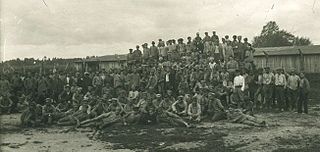
The national flag of Lithuania consists of a horizontal tricolour of yellow, green, and red. It was adopted on 25 April 1918 during Lithuania's first period of independence from 1918 to 1940, which ceased with the occupation first by the Soviet Union, and then by Nazi Germany (1941–1944). During the post-World War II Soviet occupation, from 1945 until 1988, the Soviet Lithuanian flag consisted first of a generic red Soviet flag with the name of the republic, in 1953 that was changed to the red flag with white and green bands at the bottom.

The coat of arms of Lithuania is a mounted armoured knight holding a sword and shield, known as Vytis. Since the early 15th century, it has been Lithuania's official coat of arms and is one of the oldest European coats of arms. It is also known by other names in various languages, such as Waykimas, Pagaunė in the Lithuanian language or as Pogonia, Pogoń, Пагоня in the Polish, and Belarusian languages. Vytis is translatable as Chase, Pursuer, Knight or Horseman, similar to the Slavic vityaz. Historically – raitas senovės karžygys or in heraldry – raitas valdovas.

Prienai is a city in Lithuania situated on the Nemunas River, 29 km (18 mi) south of Kaunas. In 2023 the city had 8,894 inhabitants. The name of the city is a derivative from a surname Prienas. Pociūnai Airport is associated with the city.

The Columns of Gediminas or Pillars of Gediminas are one of the earliest symbols of Lithuania and its historical coats of arms. They were used in the Grand Duchy of Lithuania, initially as a rulers' personal insignia, a state symbol, and later as a part of heraldic signs of leading aristocracy.

The Lithuanian Wars of Independence, also known as the Freedom Struggles, refer to three wars Lithuania fought defending its independence at the end of World War I: with Bolshevik forces, Bermontians, and Poland. The wars delayed international recognition of independent Lithuania and the formation of civil institutions.

The Treaty of Melno or Treaty of Lake Melno was a peace treaty ending the Gollub War. It was signed on 27 September 1422, between the Teutonic Knights and an alliance of the Kingdom of Poland and the Grand Duchy of Lithuania at Lake Melno, east of Graudenz (Grudziądz). The treaty resolved territorial disputes between the Knights and Lithuania regarding Lithuania Minor and Samogitia, which had dragged on since 1382, and determined the Prussian–Lithuanian border, which afterwards remained unchanged for about 500 years. A portion of the original border survives as a portion of the modern border between the Republic of Lithuania and Kaliningrad Oblast, Russia, making it one of the oldest and most stable borders in Europe.

The Church of St. Peter and St. Paul is a Roman Catholic church located in the Antakalnis neighbourhood of Vilnius, Lithuania. It is the centerpiece of a former monastery complex of the Canons Regular of the Lateran. Its interior has masterful compositions of some 2,000 stucco figures by Giovanni Pietro Perti and ornamentation by Giovanni Maria Galli and is unique in Europe. The church is considered a masterpiece of the Polish–Lithuanian Commonwealth Baroque. It was funded by Michał Kazimierz Pac, commemorating a victory over the Muscovites and their expulsion from Vilnius after six years of occupation.

Stanislovas Kęsgaila Jonaitis was a Lithuanian nobleman, son of Jonas Kęsgaila from the Kęsgaila family. Stanislovas Kęsgaila was the Elder of Samogitia (1486–1522), Grand Hetman of Lithuania (1501–1502), castellan of Trakai (1499–1522) and Vilnius (1522–1526).

The House of Alšėniškiai was a Lithuanian by origin Ruthenianized and predominantly Eastern Orthodox princely family of Hipocentaur coat of arms. Their patrimony was the Principality of Alšėnai, which included the castles of Rokantiškės and Alšėnai.

The Lithuanian–Soviet War or Lithuanian–Bolshevik War was fought between newly independent Lithuania and the Russian Socialist Federative Soviet Republic in the aftermath of World War I. It was part of the larger Soviet westward offensive of 1918–1919. The offensive followed the retreat of German troops and sought to establish Soviet republics in Ukraine, Belarus, Lithuania, Latvia, Estonia, Poland and link up with the German Revolution. By the end of December 1918 Soviet forces reached Lithuanian borders. Largely unopposed, they occupied one town after another and by the end of January 1919 controlled about two thirds of the Lithuanian territory. In February, the Soviet advance was stopped by Lithuanian and German volunteers, who prevented the Soviets from capturing Kaunas, the temporary capital of Lithuania. From April 1919, the Lithuanian war went parallel with the Polish–Soviet War. Poland had territorial claims over Lithuania, especially the Vilnius Region; these tensions spilt over into the Polish–Lithuanian War.

The Lithuanian Soviet Socialist Republic (LSSR) was a short-lived Soviet Puppet state during early Interwar period. It was declared on 16 December 1918 by a provisional revolutionary government led by Vincas Mickevičius-Kapsukas. It ceased to exist on 27 February 1919, when it was merged with the Socialist Soviet Republic of Byelorussia to form the Lithuanian–Byelorussian Soviet Socialist Republic (Litbel). While efforts were made to represent the LSSR as a product of a socialist revolution supported by local residents, it was largely a Moscow-orchestrated entity created to justify the Lithuanian–Soviet War. As a Soviet historian described it as: "The fact that the Government of Soviet Russia recognized a young Soviet Lithuanian Republic unmasked the lie of the USA and British imperialists that Soviet Russia allegedly sought rapacious aims with regard to the Baltic countries." Lithuanians generally did not support Soviet causes and rallied for their own national state, declared independent on 16 February 1918 by the Council of Lithuania.

The Battle of Vilnius, Wilno, or Vilna was an attack by Russian and Cossack forces on Vilnius, the capital of the Grand Duchy of Lithuania within the Polish–Lithuanian Commonwealth, that occurred on 8 August 1655 during the Russo-Polish War (1654–67). The Polish–Lithuanian forces under the leadership of Great Hetman Janusz Radziwiłł were defeated by the Russian army of Alexis of Russia. It was the first time that a foreign power managed to capture the Vilnius Castle Complex. The six-year Muscovite occupation that followed resulted in a major depopulation and a decline of the city for many years to come. The defeat was one of the reasons Janusz Radziwiłł and several other Lithuanian magnates surrendered the Grand Duchy to Sweden at the Union of Kėdainiai.

Jašiūnai is a town in Lithuania. It is situated on the Merkys River and an edge of the Rūdninkai Forest. According to the 2001 census, it had population of 1,879. The town's population is primarily Poles (74.5%), with Lithuanians (12.4%) and Russians (8.4%).

Saldutiškis is a small town in northeastern Lithuania. According to the Lithuanian census of 2011, it had 343 residents.
Stanislovas Čiupurna was a Lithuanian noble, Court (1395–1407) and Grand Marshal of the Grand Duchy of Lithuania (1407–1411). As a close ally of Grand Duke Vytautas, he was one of the chief diplomats in the conflict over Samogitia with the Teutonic Knights.
Alekna Sudimantaitis was an influential Lithuanian noble of Trąby coat of arms, Grand Chancellor of the Grand Duchy of Lithuania (1478–1490) and Voivode of Vilnius (1477–1490).
Petras Jonaitis Mantigirdaitis was a prominent Lithuanian noble. Grandson of Petras Mantigirdaitis, he first appeared in written sources in 1476 and reached his career high in the 1490s, when he was Voivode of Trakai (1490–97) and Grand Marshal of Lithuania (1491–97).

The 1st Infantry Regiment, later the 1st Infantry Regiment of the Lithuanian Grand Duke Gediminas was an infantry regiment that served in the Lithuanian Army during the Interwar period.

The Battle of Jieznas was one of the first battles of the recreated Lithuanian Army against the Red Army near Jieznas during the Lithuanian Wars of Independence. This Lithuanian victory contributed significantly to an increase in Lithuanian morale. The further Bolshevik offensive into Lithuania was stopped at the battles of Kėdainiai, Jieznas and Alytus.






















